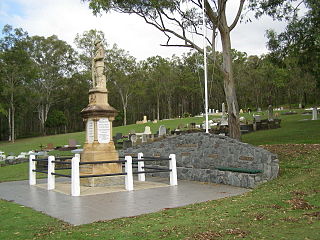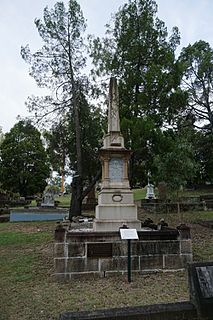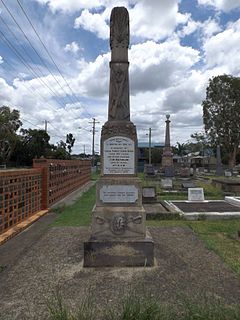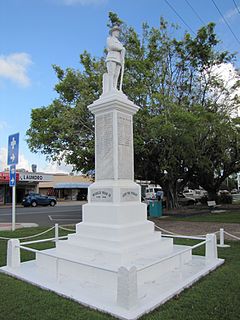
Cooyar War Memorial is a heritage-listed war memorial in Hack Menkins Park, McDougall Street, Cooyar, Toowoomba Region, Queensland, Australia. The memorial was unveiled on Saturday 14 July 1923 by Arthur Edward Moore. It was designed and produced by R. C. Ziegler and Son and cost £413/10/0, with funds raised by public subscriptions and revenue raised from entertainments. The memorial comprises two pieces, the pedestal surmounted by a digger statue, on which the names of the 25 fallen are recorded, and a smaller plinth which records the names of the 110 local men who served in World War I. It was added to the Queensland Heritage Register on 21 October 1992.

Boer War Memorial is a heritage-listed war memorial at Crescent Street, Gatton, Queensland, Australia. It was designed by William Hodgen and produced by Toowoomba mason William Bruce. It was built in 1908, and was unveiled on 3 August by Governor of Queensland, Lord Chelmsford. The memorial honours four local men who died in or as a result of the war, and is one of only three known Boer War memorials in Queensland. It is also known as the Fallen Soldiers Memorial and the South African War Memorial.

Beaudesert War Memorial is a heritage-listed memorial at William Street, Beaudesert, Queensland, Australia. It was built from 1919 to 1921. It was added to the Queensland Heritage Register on 21 October 1992.

Boonah War Memorial and Memorial Park is a heritage-listed memorial at Park Street, Boonah, Scenic Rim Region, Queensland, Australia. It was built from 1920 to 1922. It was added to the Queensland Heritage Register on 21 October 1992.

Pimpama & Ormeau War Memorial is a heritage-listed memorial at Pacific Highway, Pimpama, Queensland, Australia. It was built in 1919. It was added to the Queensland Heritage Register on 21 October 1992.

Ithaca War Memorial and Park is a heritage-listed memorial and park at Enoggera Terrace, Paddington, Queensland, Australia. The memorial was designed and built by Arthur Henry Thurlow between 1921 and 1925. The park was built and designed by Alexander Jolly. It is also known as Alexander Jolly Park. It was added to the Queensland Heritage Register on 21 October 1992.

Caskey Monument is a heritage-listed memorial at the Toowong Cemetery, 124 Birdwood Terrace, Toowong, City of Brisbane, Queensland, Australia. It was designed and built by William Busby in 1902. It was added to the Queensland Heritage Register on 21 October 1992.

Berry & MacFarlane Monument is a heritage-listed memorial at Sherwood Road, Sherwood, Queensland, Australia. It was built in 1902. It was added to the Queensland Heritage Register on 21 October 1992.

Booval War Memorial is a heritage-listed memorial at Green Street, Booval, City of Ipswich, Queensland, Australia. It was built in 1919. It was added to the Queensland Heritage Register on 21 October 1992.

The Boer War Memorial is a heritage-listed memorial at Warwick Street, Allora, Southern Downs Region, Queensland, Australia. It was built from 1904 to 1940s. It is also known as Queen's Park and War Memorial Park. It was added to the Queensland Heritage Register on 21 October 1992.

Brooweena War Memorial is a heritage-listed memorial at Smith Crescent, Brooweena, Fraser Coast Region, Queensland, Australia. It was built in 1922 by F W Webb. It was added to the Queensland Heritage Register on 21 October 1992.

Howard War Memorial is a heritage-listed memorial at William Street, Howard, Fraser Coast Region, Queensland, Australia. It was built in 1921. It was added to the Queensland Heritage Register on 21 October 1992.

Apple Tree Creek War Memorial is a heritage-listed memorial at Bruce Highway, Apple Tree Creek, Bundaberg Region, Queensland, Australia. It was designed and built in 1921 by Andrew Lang Petrie. It was added to the Queensland Heritage Register on 21 October 1992.

Miriam Vale War Memorial is a heritage-listed memorial at Blomfield Street, Miriam Vale, Gladstone Region, Queensland, Australia. It was built in 1921. It was added to the Queensland Heritage Register on 21 October 1992.

Coronation Lamp is a heritage-listed war memorial at Morgan Street, Mount Morgan, Rockhampton Region, Queensland, Australia. It was designed by Arthur Jenks and built from 1902 to 1947. It is also known as Boer War Memorial and The Coronation Light. It was added to the Queensland Heritage Register on 21 October 1992.

Rockhampton War Memorial is a heritage-listed memorial in the Rockhampton Botanic Gardens at Penlington Street, The Range, Rockhampton, Rockhampton Region, Queensland, Australia. It was built in 1924. It was added to the Queensland Heritage Register on 21 October 1992.

Finch Hatton War Memorial is a heritage-listed memorial at Anzac Parade, Finch Hatton, Mackay Region, Queensland, Australia. It was designed by Melrose & Fenwick and built in 1921 by Melrose & Fenwick. It was added to the Queensland Heritage Register on 21 October 1992.

Sarina War Memorial is a heritage-listed memorial at Broad Street, Sarina, Mackay Region, Queensland, Australia. It was built in 1919 by Melrose and Fenwick. It was added to the Queensland Heritage Register on 5 December 1997.

Barcaldine War Memorial Clock is a heritage-listed memorial at Ash Street, Barcaldine, Barcaldine Region, Queensland, Australia. It was designed and built in 1924 by monumental masons Andrew Lang Petrie and Son. It was added to the Queensland Heritage Register on 21 October 1992.

Dalby War Memorial and Gates is a heritage-listed memorial at Patrick Street, Dalby, Western Downs Region, Queensland, Australia. It was designed and built in 1922 by Harry Shill and British firms. It was added to the Queensland Heritage Register on 21 October 1992.





























